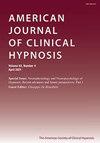国际催眠术文献综述
IF 1.2
4区 心理学
Q3 PSYCHOLOGY, CLINICAL
引用次数: 0
摘要
本系统综述和荟萃分析评估了催眠、音乐和音乐催眠在帮助绝症患者缓解疼痛、焦虑、睡眠和健康方面的作用。随机对照试验和非随机研究采用了描述其方案的前后设计。共纳入11项研究(5项RCT), 579名受试者符合纳入标准。对前后设计研究的分析表明,在疼痛、焦虑、睡眠和健康方面有希望的结果。RCT的荟萃分析显示疼痛显著减少(效应值- 0.42),但没有足够的研究(4)来分析对其他感兴趣变量的影响。值得注意的是,这种效果主要是由一项将催眠和音乐结合起来的研究推动的。有几项研究在招募和留住参与者方面存在困难。作者建议,涉及绝症患者的研究和干预应特别注意干预的持续时间和疗程的长短。如何优化这些有利因素还需要进一步的研究。在姑息治疗期间使用催眠和音乐具有最小的风险或副作用,并有可能改善生活质量。转载地址:蒙特蒙特大学麻醉学和疼痛医学系,蒙特蒙特大学。作者对各种形式的社会心理干预措施的证据进行了回顾,以帮助患有牙科焦虑症的患者。患者可能会表现出轻微到严重的牙齿焦虑,这不仅使治疗变得更加困难,而且还会阻止一些患者寻求他们可能迫切需要的治疗。作者确定了一些有前途的干预措施,如催眠、放松、生物反馈和心理治疗,这些措施已经证明对患有牙科焦虑症的患者有效。作者旨在量化催眠治疗慢性肌肉骨骼疼痛和/或神经性疼痛的有效性。在这个系统回顾和荟萃分析中,随机对照试验使用催眠和/或自我催眠来控制疼痛,以及严重的炎症反应和水泡,导致额外的皮肤和眼睛损伤,在某些情况下还会损害肺部。史蒂文斯-约翰逊综合征和中毒性表皮坏死松解的烧伤患者在康复过程中会遭受额外的创伤,医疗提供者通常认为他们还会遭受自尊、抑郁、焦虑和创伤后应激障碍的困扰。考虑到这些患者在康复过程中面临的严重的生活质量问题,作者希望看看是否有研究报告了治疗史蒂文斯-约翰逊综合征和中毒性表皮坏死松解的烧伤患者的成功结果。作者甚至找不到一项定量或定性的研究来检验使用任何形式的心理治疗来治疗这些伴有史蒂文斯-约翰逊综合征和中毒性表皮坏死松解的烧伤患者。然而,他们确实发现了17项研究,这些研究检查了使用心理疗法治疗患有抑郁、焦虑和创伤后应激障碍等生活质量问题的烧伤患者。作者的结论是,这些干预措施中有许多似乎显示出一些希望,可以用更好的方法进行后续研究。认知行为疗法结合催眠就是一种干预,他们认为这是一种有希望的心理治疗形式。利默里克学院,这是一项有趣的后续研究,该实验通过一项基于调查的研究的标准化心理治疗来比较肠易激综合征和腹痛的催眠,该研究向医护人员询问他们在covid - 19等灾难性事件中应对与照顾患者相关的压力的经历。该研究是在2021年夏季与各种医疗服务提供者一起进行的。此前,日内瓦大学医院实施了各种干预措施,以帮助医院员工进行各种减压干预措施,如催眠、心理学家咨询、精神病学咨询和24小时热线护理本文章由计算机程序翻译,如有差异,请以英文原文为准。
Review of the international hypnosis literature
This systematic review and meta-analysis evaluated the use of hypnosis, music, and hypnosis with music to help terminally ill individuals with their pain, anxiety, sleep, and well-being. Randomized Controlled Trials and non-randomized studies with a pre-post design that described their protocol were used. A total of 11 studies (5 RCT), with a total of 579 participants met the inclusion criteria. Analysis of the pre-post design studies indicated promising results for pain, anxiety, sleep, and well-being. The meta-analysis of RCT showed a significant decrease in pain (effect size −0.42), but there were not enough studies (4) for an analysis of the effects on other variables of interest. It is of note that this effect was largely driven by one study that combined hypnosis and music. Several studies had difficulty recruiting and retaining participants. The authors suggest that research and interventions involving the terminally ill, should pay particular attention to the duration of the intervention and the length of the sessions. Further research is needed to better understand the how to optimize these favorable benefits. The use of hypnosis and music during palliative care has minimal risk or side effects, and the potential to improve life quality. Address for reprints: Department of Anesthesiology and Pain Medicine, Université Montréal, Québec, The authors present a review of the evidence for various forms of psychosocial interventions to help patients with dental anxiety. Patients can present with mild to severe forms of dental anxiety that not only make treating them more difficult but also stop some patients from seeking treatment that they may urgently need. The authors identified a number of promising interventions such as hypnosis, relaxation, biofeedback, and psychotherapy that have demonstrated some evidence for their efficacy with patients who have difficulties with dental anxiety. The authors aimed to quantify the efficacy of using hypnosis for pain in adults with chronic musculoskeletal pain and/or neuropathic pain. In this systematic review and meta-analysis, Randomized Control Trials that used hypnosis and/or self-hypnosis to manage pain, and severe inflammatory response with blisters leading to additional skin and eye damage, as well as damage to the lungs in some cases. Burn patients with Stevens-Johnson syndrome and toxic epidermal necrolysis suffer from additional trauma in their recovery and it is commonly thought by medical providers that they also suffer from difficulties with self-esteem, depression, anxiety, and PTSD. The authors wished to see if any research had reported successful results with psychotherapy for burn patients with Stevens-Johnson syndrome and toxic epidermal necrolysis, given the severe quality of life problems that these patients face in their recovery. The authors were unable to find even one quantitative or qualitative study examining the use of any form of psychotherapy for the treatment of these burn patients with Stevens-Johnson syndrome and toxic epidermal necrolysis. However, they did find seventeen studies which examined the use of psychotherapy for the treatment of burn patients with quality-of-life issues like depres-sion, anxiety, and PTSD. The authors concluded that many of these interventions did appear to show some promise for follow-up studies with better methodology. The use of cognitive behavior therapy with hypnosis was one such intervention that they identified as showing promise as a therapeutic form of psychotherapy. Department of and Limerick, individual pediatric irritable functional abdominal This is an interesting follow-up study to an experiment that compared hypnosis for irritable bowel syndrome and abdominal pain administered via standardized psychotherapy of a survey-based study asking healthcare workers about their experiences coping with the stresses associated with caring for patients during catastrophic events such as the Covid19 The study was conducted the with a variety of medical care providers during the summer 2021. Previously, Geneva University Hospital had implemented a variety of interventions to help hospital employees with a variety of stress reduction interventions as sessions hypnosis, sessions with a psychologist, psychiatric consults, and a 24-hour hotline care
求助全文
通过发布文献求助,成功后即可免费获取论文全文。
去求助
来源期刊

American Journal of Clinical Hypnosis
PSYCHOLOGY, CLINICAL-
CiteScore
2.00
自引率
23.10%
发文量
52
期刊介绍:
The American Journal of Clinical Hypnosis ( AJCH) is the official publication of the American Society of Clinical Hypnosis (ASCH). The Journal publishes original scientific articles and clinical case reports on hypnosis, as well as books reviews and abstracts of the current hypnosis literature. The purview of AJCH articles includes multiple and single case studies, empirical research studies, models of treatment, theories of hypnosis, and occasional special articles pertaining to hypnosis. The membership of ASCH and readership of AJCH includes licensed health care professionals and university faculty in the fields of medicine, psychiatry, clinical social work, clinical psychology, dentistry, counseling, and graduate students in these disciplines. AJCH is unique among other hypnosis journals because its primary emphasis on professional applications of hypnosis.
 求助内容:
求助内容: 应助结果提醒方式:
应助结果提醒方式:


